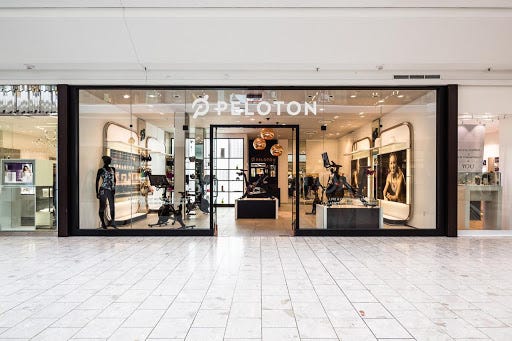Peloton launched their indoor exercise bike in 2012 led by CEO John Foley. The Peloton brand has built a passionate community based around their one of a kind experience. With a well executed launch and clever marketing tactics, they ultimately become industry leaders.
Strategy 1: Kickstarter
In 2013 they launched on Kickstarter, raising over 307K from 297 backers. They leveraged kickstarter to raise money to scale manufacturing and build early buzz for the brand. This led to tons of PR from the Wall Street Journal, TechCrunch, Time, and more.
As word spread about Peloton, many articles and PR linked back to Peloton’s website. These backlinks from highly reputable sources significantly improved Peloton’s SEO, giving their website a boost in search algorithms. This helped more people learn about Peloton early on.
Strategy 2: Email Loop
To keep the early momentum alive from the launch, they sent emails encouraging those who funded to share Peloton with friends. To make sure nobody forgot about Peloton, they sent emails with special deals and future products such as their cycling shoes.
This not only prolonged the launch buzz, but it helped Peloton establish its brand messaging, tonality, and voice. The emails showcased their energy and positivity which is what the brand is all about. It also helped build an early feedback loop with their earliest users.
Strategy 3: Cult Community
Peloton brings people together to form a community focussed on connections. Competing with others on the leaderboard, instructors congratulating your ride milestones, even giving virtual high fives and birthday shoutouts is what makes the community.
The instructors are the secret sauce - groomed, stylish, loud personalities and soundtracks draw people to their individual classes. They were all poached from top boutique fitness studios, many with large social media followings who brought their audience to peloton.
Strategy 4: Word of Mouth
The experience has generated mass word of mouth, Peloton has built an army of loyal members - in fact peloton has sold more bikes through word of mouth than direct from the website.
Subscriber churn remains low with a 12 month retention rate of 92%.
The community itself generates big word of mouth. Once you join the worldwide Peloton community and embrace the experience of being a part of the live classes, users can’t stop but telling others about how amazing it is.
Strategy 5: Product Placement
In 2013 Peloton set up their first store in a new jersey luxury mall. According to a 2019 interview, it was the best 4 months of peloton sales ever. The purpose however wasn’t to sell bikes in person, but for top of funnel awareness.
People came to the store and tried them out.
They also put Pelotons in high end hotels. In the beginning their target audience was higher income users, however since then they've offered affordable payment plans to capture more market.
Peloton Today:
1M+ subscribers
500K+ bikes sold
66% revenue growth over the last year
Keys to Growth Success:
Leveraged momentum from kickstarter and press
Built a strong cult-like community
Strong word of mouth
Smart product placement
If you enjoyed this thread:
1. Subscribe to my SubStack for a more in depth breakdown of Peloton's growth
https://thegrowthplaybook.substack.com/welcome
2. Follow me on Twitter @growth_student for a new growth thread like this every week!
https://twitter.com/growth_student
Sources:
https://www.bnnbloomberg.ca/peloton-founder-goes-from-kickstarter-to-a-450-million-fortune-1.1315142
https://leapfin.com/blog/pelotons-path-to-become-a-50b-connected-fitness-behemoth/
https://www.fool.com/investing/2021/03/03/underrated-factors-growth-peloton-interactive/#:~:text=Part%20of%20Peloton's%20growth%20strategy,are%20communicating%20that%20to%20friends.
https://www.launchnotes.com/blog/how-they-launched-it-peloton#email
https://www.cnbc.com/2019/02/12/how-peloton-exercise-bikes-and-streaming-gained-a-cult-following.html







